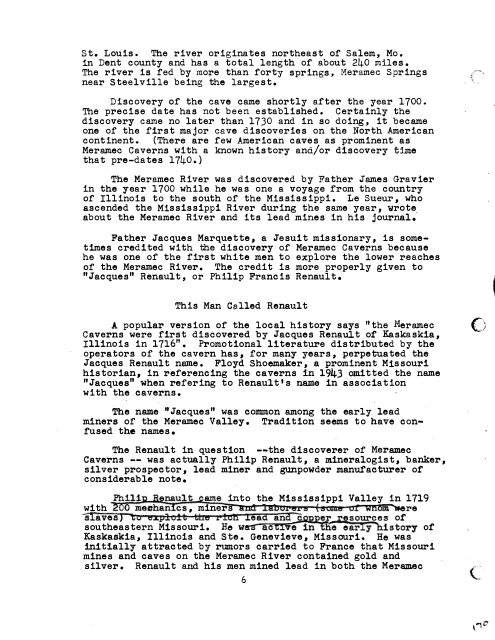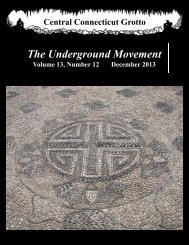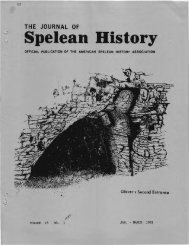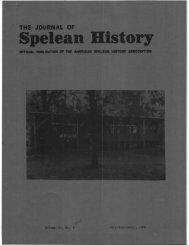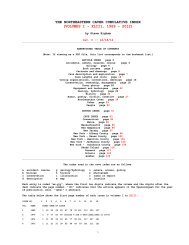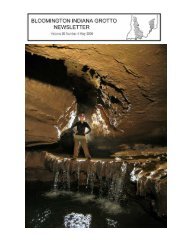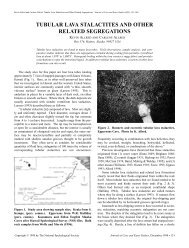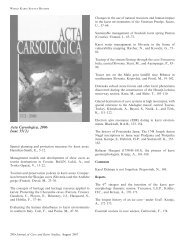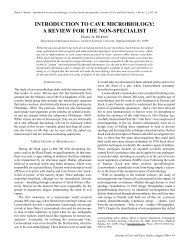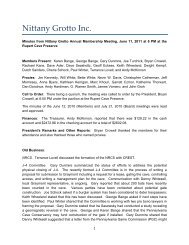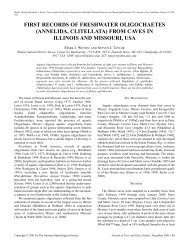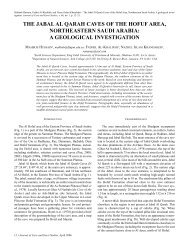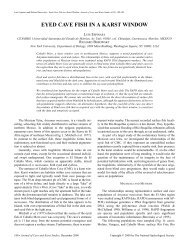021 (Winter 1973) - National Speleological Society
021 (Winter 1973) - National Speleological Society
021 (Winter 1973) - National Speleological Society
You also want an ePaper? Increase the reach of your titles
YUMPU automatically turns print PDFs into web optimized ePapers that Google loves.
st. Louis. The river originates northeast of Salem, Mo.<br />
in Dent county and has a total length of about 240 miles.<br />
The river is fed by more than forty springs, Meramec Springs<br />
near Steelville being the largest.<br />
Discovery of the cave came shortly after the year 1700.<br />
The precise date has not been established. Certainly the<br />
discovery came no later than 1730 and in so doing, it became<br />
one of the first major cave discoveries on the North American<br />
continent. (There are few American caves as prominent as<br />
Meramec Caverns with a known history and/or discovery tjme<br />
that pre-dates 1740.)<br />
The Meramec River was discovered by Father James Gravier<br />
in the year 1700 while he was one a voyage from the country<br />
of Illinois to the south of the Mississippi. Le Sueur, who<br />
ascended the Mississippi River during the same year J wrote,<br />
about the Meramec River and its lead mines in his journal.<br />
Father Jacques Marquette, a Jesuit missionary, is sometimes<br />
credited with the discovery of Meramec Caverns because<br />
he was one of the first white men to explore the lower reaches<br />
of the Meramec Ri ver. The credit is more properly given to<br />
"Jacques" Renault, or Philip Francis Renault.<br />
This Man Called Renault<br />
A. popular version of the local history says Itthe l"1eramec<br />
Caverns were first discovered by Jacques Renault of Kaskaskia,<br />
Illinois in l716tt• Promotional literature distributed by the<br />
operators of the cavern has, for many years, perpetuated the<br />
Jacques Renault name. Floyd Shoemaker, a prominent Missouri<br />
historian, in referencing the caverns in 1943 amitted the name<br />
"Jacques" when refering to Renault's na in association<br />
with the caverns.<br />
C·" '.. ,J<br />
The name ttJacques" was common among the early lead<br />
miners of the Meramec Valley. Tradition seems to have confused<br />
the names.<br />
The Renault in question --the discoverer of Meramec <br />
Caverns -- was actually Philip Renault, a mineralogist, banker, <br />
silver prospector, lead miner and gupowder manufacturer of <br />
considerable note. <br />
Philip Renaultame into the Mississippi Valley in 1719 <br />
with OO mechanIcs, miners an labalers (som ot whi_re<br />
sIaves) to exo1t th ric lead and eRPpe resources of<br />
southeastern Missouri. He was active in=te earlybistory of<br />
Kaskaskia, Illinois and Ste. Genevieve, Missouri. He was<br />
initially attracted by rumors carried to France that Missouri<br />
mines and caves on the Meramec River contained gold and<br />
silver. Renault and his men mined lead in both the Meramc<br />
6


